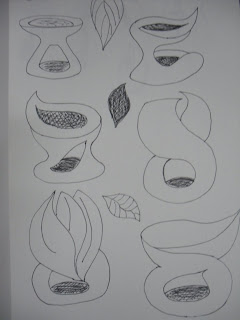This whole experience for the past three months is just the beginning of my relationship with clay. It has given me great insights on clay as a student and a whole new perspective as an educator. I've ventured into various art forms such as acryllic and oil painting, printmaking, photography and digital art before and none has touched me deeply as how clay did. With clay, I found myself breaking new grounds, going beyond my comfort level. And I found myself breaking a few pots as well.
I guess the frustrations I felt helped me to identify better with the pupils in my class who may be struggling to learn something new. The things that I've learnt could be applied to other disciplines as well and I am now slightly more confident and optimistic about setting up my own clay studio in school. At least, I have a clearer idea of what I would be in for.
I guess my greatest challenge in working with clay was to overcome my own fear. I was afraid of the simplest thing like to make carvings on my pots or to even decide on the design of my form as I feared that it would not work out. I even feared that I would not have enough time to complete my work and so I procrastinated on even getting started. The fear gave me a slow start to things but once I overcame that, there was no stopping. That led to another hurdle as the fatigue from continuously working on on pot, and not know when to stop, physically drained me out.
Though I am not able to fully admit that I have managed to overcome all the hurdles, I am able to manage them better now. One of the ways that I found useful was to sketch out any ideas that came to mind. I trawled through websites to seek out ideas that appealed to me. I have to keep reminding myself to snap out of my reverie at times and to instead pen down my visualisations to make them real. Another thing I had to work on was my time management. I was worn out and had to bring my school work home on work days and thus was unable to commit myself to long hours in the studio. Thus, I had to make time on my rest days and commit myself to studio work. Setting a stop time would help too as I tend to get carried away once I get started. Keeping a journal or for my case, a blog, also helped me along in this journey as penning down my thoughts kept me connected to what I was doing.
Throughout this journey, my primary focus had been on the processes involved rather than the product. I still consider my works to be pretty conservative and have yet to venture into making something more adventurous. I wanted to digest the basics of every method and took the time to think, make mistakes and recover. I think the wonderful thing I experienced was the transformation of the ideas at the various stages. An accidental mark on the pot may spark of an impromptu design and at times I found myself yielding to what the clay wants instead. At the end of it all, my satisfaction came from having experienced each of the process from the start till the end. Though it has come to the end of the course, for me, it is just the start.
Tuesday, April 13, 2010
Saturday, April 10, 2010
Tuesday, April 6, 2010
Useful Links for the Classroom
Here are some great finds from the web that you may help you in the classroom.
Comprehensive Lesson Plans
Example of a Pottery Class Assignment
Lesson Ideas
Comprehensive Lesson Plans
Example of a Pottery Class Assignment
Lesson Ideas
Basic Ceramics1
View more presentations from Noreen Strehlow.
Friday, April 2, 2010
Moulding Clay

Apparently, I found that clay is humanlike in many ways. First of all, it has to be treated with respect. It has to kept properly and be given enough time to recuperate. You will know that your clay is stressed out when it breaks easily. That moment signals for rest. Keep the clay aside under a wet rag first or better still, keep it wrapped in plastic. Air dries the clay up as it is mainly composed of water and earth. You must not neglect it for too long either as it will become pretty uncooperative.
Like a child, soft clay can be shape a moulded to your desired product. An important stage where foundations are laid, you have to prepare it properly. No shortcuts here. Leather-hard clay is somewhat like a teenager. Though rebellious in nature, there is still room for change. Clay that has set is like an adult. Not much change or addition can be made at this stage. It breaks easily too. Handle it with care.
Subscribe to:
Comments (Atom)








